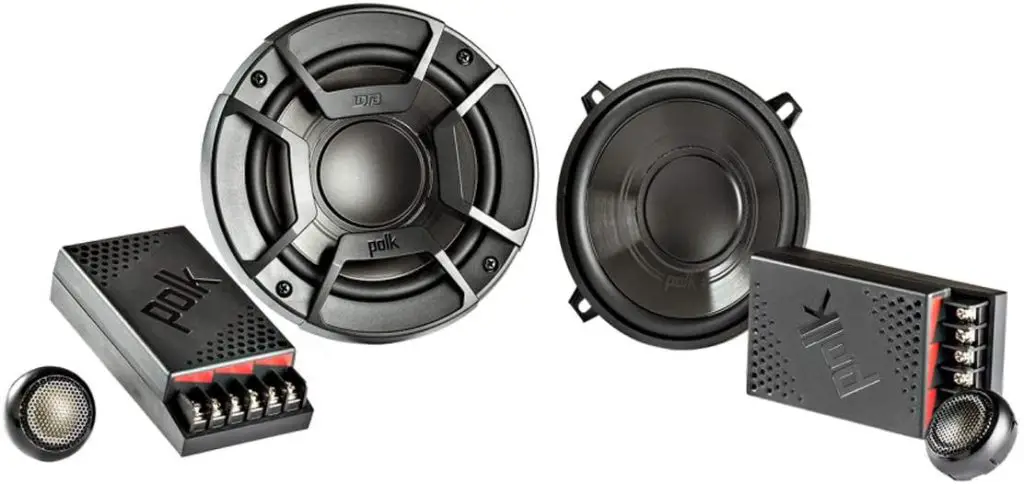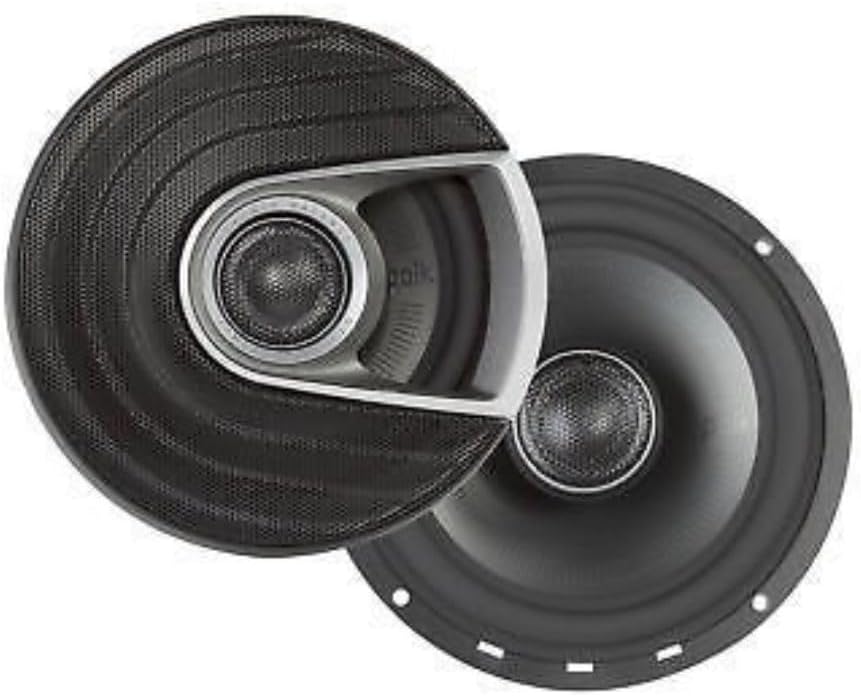Speakers are a critical part of any home theater or stereo system. They transform electrical audio signals into sound waves that you can hear. There are two main types of loudspeakers for home audio – component speakers and coaxial speakers. Both have their advantages and disadvantages. In this guide, we’ll compare component and coaxial speakers to help you decide which is better for your needs.
What are Component Speakers?

Component speakers, also known as separate speakers, are a speaker system where the tweeter, midrange driver, and woofer are separate components.
- The tweeter handles the high frequencies. It is usually a small dome-shaped driver.
- The midrange driver reproduces the middle frequencies.
- The woofer or subwoofer handles the low frequencies. This is usually a larger cone-shaped driver.
In a component speaker system, the crossover, which splits the audio signal into different frequency ranges, is separate from the drivers. The crossover can be passive (using capacitors and inductors) or active (powered).
Component speaker systems offer more flexibility in setting up your speakers. You can place the tweeter separately from the woofer for better sound staging. The individual drivers can also be of higher quality since each one handles a specific frequency range.
Component speaker system with separate tweeter, midrange, and woofer
Advantages of Component Speakers:
- More flexibility in speaker positioning and placement
- Individual drivers are optimized for specific frequency ranges
- Can upgrade specific drivers instead of entire speaker
- Better high frequency response from dedicated tweeters
- Advanced crossover designs possible (active crossovers)
- High-end audio quality potential
Disadvantages of Component Speakers:
- More expensive than coaxial speakers
- Complex setup with multiple speaker wires
- Bulky, heavy, and aesthetically unattractive
- Passive crossovers can degrade audio quality
- Require more installation space
What are Coaxial Speakers?

Coaxial speakers, also known as full-range speakers, have the tweeter placed in front of the woofer in a single unified enclosure. This allows the entire frequency range to come from one location.
In a coaxial speaker, the tweeter is mounted on a small pole in the middle of the woofer. The crossover is integrated into the speaker enclosure.
Coaxial speakers are a two-way design – they have one driver handling the high frequencies (the tweeter) and one driver covering the midrange and low frequencies (the woofer). Some coaxial speakers add a super tweeter for enhanced high-end response.
Coaxial speaker with tweeter mounted on pole in front of woofer
Advantages of Coaxial Speakers:
- Compact, single speaker cabinet per channel
- Easier to install due to less wiring
- Cost effective and affordable
- Built-in crossover simplifies setup
- Broad frequency response from single location
- Consistent sound between different seats
Disadvantages of Coaxial Speakers:
- Limited flexibility in placement
- Sound quality not as good as component speakers
- Tweeters prone to interference from woofer
- Full-range woofers cannot reproduce all frequencies optimally
- Built-in crossovers can cause distortion and power loss
Now that we’ve compared the basics of component and coaxial speakers, let’s dive deeper into how they differ.
Sound Quality
The biggest advantage of component speakers is the potential for better sound quality. Since the woofer, tweeter and crossover are separate, they can be designed optimally for the frequencies they reproduce.
The dedicated tweeters in component systems are better at reproducing high frequencies than the tweeter-woofer combination in coaxials. The tweeters have greater power handling, lower distortion, and wider dispersion. This leads to smoother, more natural sounding highs.
The woofers in component systems also perform better by focusing only on low and mid frequencies. They can use larger magnets, voice coils, and cones to optimize bass response. The larger cabinet size also improves bass extension.
The crossovers in component speakers tend to be more advanced, using higher order slopes and better components. This allows for each driver to receive only the frequencies it can handle, reducing distortion.
Coaxial speakers cannot match this performance since their woofer has to try to cover all frequencies except for the highest highs. This leads to compromises in cone materials, magnet strength, and frequency response. Their limited cabinet size also reduces low frequency extension compared to separate woofers.
Overall, component speakers can deliver wider, flatter, more accurate frequency response leading to better sound quality for both music and movies. Their separation of woofers, tweeters, and crossovers improves performance across the frequency spectrum.
Customization and Placement
Component speaker systems offer more flexibility in setup configurations. You can experiment with different tweeter and woofer positions to optimize the soundstage and stereo imaging.
Some tips for placement of component speakers:
- Place tweeters closer to ear level for better high frequency response
- Position woofers/midrange drivers further apart for wider soundstage
- Add more woofers spread throughout the room for deeper, fuller bass
- Angle tweeters towards the listening area to improve high frequency dispersion
With coaxial speakers, you are limited to placing them as a single unit. While this makes setup easier, you cannot tweak the individual tweeter and woofer positions. Coaxials often end up with the tweeter either too low or too high relative to the listener.
Component speakers also allow you to upgrade specific drivers. For example, you may be happy with the woofers but want to improve the tweeters. With coaxials, replacing the speaker requires changing the entire unit.
Power Handling
Component speakers tend to have higher power handling capacities than coaxial speakers. Since the woofers, tweeters and crossovers are optimized for their frequency ranges, they can handle more power without damage or distortion.
The woofers of component speakers use larger voice coils, magnets and cones with greater excursion capabilities. This allows them to receive more amplifier power and reproduce louder, deeper bass.
Dedicated tweeters are also more efficient than integrated coaxial tweeters so they can handle more power. Heat dissipation is improved in separated tweeters which lowers distortion at high volumes.
Passive crossovers in some coaxial speakers can overheat or cause distortion when pushed to their limits. The more advanced crossovers of component speakers have higher power handling. Active crossovers can also provide amplification to each driver.
If planning to play music or movies at loud volumes, or use speakers with high power amplifiers, component speakers are the safer bet for reliability. Their individual drivers are designed to handle the heat and excursion demands of high power levels.
Cost and Complexity
The main tradeoff with component speakers is their higher cost and complexity compared to coaxials. You need separate speaker wire runs to each tweeter, woofer and crossover component. This can make installation in walls and ceilings more difficult.
Coaxial speakers only require a single speaker wire connection to each cabinet. This greatly simplifies wiring, especially for surround sound or multi-room audio setups. Installation is quicker with less customization needed.
Component speakers also cost more than coaxials with equivalent driver sizes. For example, a set of 6.5” component speakers sells for $200-300 while 6.5” coaxials can be $100-150. You are paying extra for the crossover network and separate tweeters.
Labor costs are also higher to install component speakers due to the more intensive wiring and placement requirements. This may outweigh the benefits of components for some users looking for simpler, more affordable setups.
Which Speakers Are Best For Different Uses?
Now that we’ve compared component and coaxial speakers, which type is better suited for various home audio applications?
For Background Music – Coaxial Speakers
If using speakers primarily for background music in a kitchen, office, or other multipurpose room, coaxial speakers offer a cost-effective solution. You don’t need the ultimate sound quality or customization ability of components for casual listening. Coaxials provide full-range sound from a simple, compact enclosure.
For Home Theater – Component Speakers
To create an immersive home theater with surround sound, component speakers can achieve clearer dialogue, wider soundstaging, and punchier bass effects. Dedicated tweeters, woofers and strategic placement provide a true cinematic experience. Passive crossovers maintain signal purity for each channel.
For Stereo Music Listening – Component Speakers
Audiophiles wanting to hear every detail in their music will prefer component speaker systems. The superior imaging, spectral separation, and realistic reproduction of high-res music formats justifies their higher cost for dedicated listeners. Customizable placement also helps achieve optimal acoustic performance.
For Multi-room Audio – Coaxial Speakers
For whole home audio systems with speakers in every room, coaxial speakers simplify installation with single-wire connectivity. Multi-zone receivers can drive each pair of coaxials for background music across the entire house. Component speakers are overkill when just needing distributed audio coverage versus high fidelity performance.
For Outdoors – Coaxial Speakers
Outdoor speakers need to withstand moisture, humidity and temperature extremes. Coaxial designs are self-contained and durable for deck, patio and poolside use. Passive crossovers can corrode but coaxials avoid that issue. The simpler wiring and water resistance makes coaxials the pragmatic outdoor speaker choice.
For Marine Use – Coaxial Speakers
On boats and yachts, coaxial speakers are again preferred for their direct wiring and all-weather capability. Salt spray, rolling waves and moisture can damage exposed component crossovers and tweeters. Coaxials mounted in marine enclosures provide full-range sound with minimal corrosion issues.
For Compact Spaces – Coaxial Speakers
For small cabinets, under cabinet, wall or ceiling applications, compact coaxial speakers fit into tight spaces. Their single-unit enclosures conserve real estate versus separate component drivers and crossovers. Integrated coaxial designs maintain utilitarian aesthetics for discrete built-in installations.
In Summary:
Here’s a quick recap of the main differences between component and coaxial speakers:
Component Speakers
- Separate woofer, tweeter and crossover
- Advanced crossover designs for optimal performance
- Allows flexible positioning of drivers
- Upgradeable individual drivers
- Better high frequency response
- Wider, deeper bass response
- Handles more power with lower distortion
- Costlier, more complex to install
Coaxial Speakers
- Tweeter and woofer in single enclosure
- Integrated crossover inside cabinet
- Compact, usually single-wire hookup
- Affordable, easy to install
- Consistent sound across seats
- Durable for outdoor and marine use
- Limitations in bass and highs
- Lower max power handling
The Bottom Line
It’s hard to declare either component or coaxial speakers as an outright “winner” – they both have advantages based on the intended use.
Coaxial speakers offer the best value and simplicity for casual background listening, distributed audio, and rugged installations. Their compact form fits easily into any space.
For critical listening and home theater, audiophile-grade component speakers deliver clearer, more lifelike sound quality given proper placement and support electronics. They reveal nuances lost with coaxials.
The most important factors are your space constraints, installation challenges, budget, and performance objectives. Consider if sound quality is worth the added complexity of component speakers. Also think if coaxial speakers are “good enough” to provide pleasing audio for less.
To get the best sense of each type’s sound, visit a showroom to demo both options. There are outstanding speakers of each variety so listen before deciding. With an informed decision based on your needs and ears, you can confidently choose the right speaker system for your room and budget. The difference between components and coaxials is less absolute than ever – let your own preferences determine which is the better fit.

